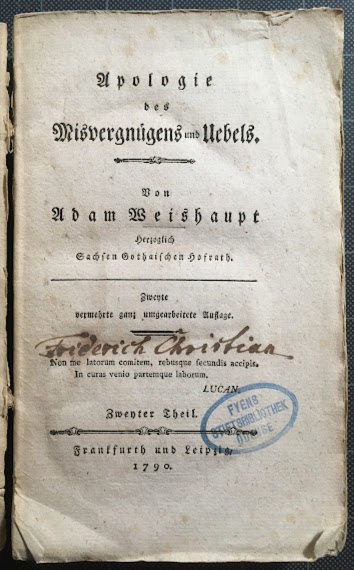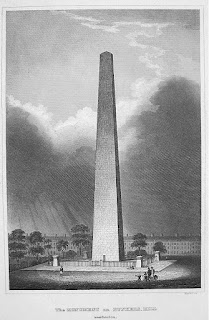On this date in 1788, Jews of the Austrian Empire were required (by a decree of the preceding August) to assume permanent given names and surnames and maintain communal vital records in the German language. It was a portentous step in more ways than one. It embodied all the contradictions of enlightened absolutist policy (and by extension, Enlightenment doctrine itself). On the one hand, it implied equality of citizens and broke down the old barriers of both parochialism and exclusion. On the other hand, it made clear that the price was adherence to a unitary norm and a forced assimilation to the dominant culture.
Most Central and Eastern European Jews had no stable surnames, referring to themselves in the traditional religious manner as son of so-and-so, identifying themselves by place of birth/residence, or both. (Thus, for example, the great German-Jewish
philosopher Moses Mendelsssohn was originally known as Moses Dessau—after his hometown—and even his secular surname or pen name, literally, "son of Mendel," was a Germanization of the Hebrew patronymic: his father was known as Menachem Mendel Dessau). One can readily understand why this situation would prove vexing for a centralizing state intent upon exercising an ever greater and more homogenizing authority over the lives of its subjects. The name law was part of the series of comprehensive reforms enacted by Emperor Joseph II.
 |
| Emperor Joseph II (detail of copper engraving; Frankfurt, 1781) |
A friend once told me he had heard a German remark that the Jews got all the loveliest German names. It is true, for example, that many such names relate to gemstones and the beauties of nature: sapphire (Saphir), diamond (Diamant), gold (Gold, Goldfarb, Goldstein, etc.), ruby (Rubin, Rubinstein, etc.), amber (Bernstein), field or valley of flowers (Blumenfeld, Blumenthal), valley of lilies (Lilienthal), roses (Rose, Rosenblum, Rosenfeld, Rosenthal), and so forth.
In fact, of course, the Jews also got some of the most comical or unattractive names: Galgenholz (gallows wood), Pulverbestandteil (component of powder), Maschinendraht (machine wire), Saumagen (sow's stomach), Wanzenknicker (bug cracker), Hungerleider (starvling), Wohlgeruch (good smell), Fresser (glutton), Einhorn (unicorn), Mist (manure), Küssemich (kiss me), Groberklotz (rough block of wood), etc. etc.
There have been many assertions about the nature and consequences of the Josephine name decrees. As tradition has it, unsympathetic and mercenary officials assigned Jews names depending on whim or the applicant’s ability to pay.
When I was in college, the great German-Jewish historian (and inveterate ironist)
George Mosse once said, in a lecture:
And there was some poor little Jew from the ghetto who stank to high heaven, and they named him "Tülpenfeld" [field of tulips] or "Veilchenduft" [fragrance of violets] and thought it was hilarious.
It's like an old German-Jewish joke from Central Europe:
The decree is issued that Jews must take on German names.
The husband comes back from the naming office.
The wife, with curiosity: "So, what are we called now?"
The husband: "Shirthead."
The wife: "Vey iz mir! Couldn't you have chosen a more respectable name?!"
The husband: "What do you mean, 'chosen,' with this band of thieves? I paid 50 Gulden extra for the 'r' alone!"
It is puzzling at first sight. The law and its subsequent additions did not speak of assigning names, although they did prohibit the use of place names or common or distinguished German surnames. (A list specified only acceptable given names.) Surprisingly, there was long no authoritative explanation of how the policy actually worked, and most of what passes for accepted fact is merely received wisdom that has to be viewed with a certain skepticism.
 |
| The Austrian Empire, from Conrad Malte Brun, Atlas Complet (Paris, 1812). Galicia is the yellow-bordered region to the northeast |
To the extent that we now better understand the actual origins and patterns of Jewish names in Galicia (home to the largest Jewish population in the Empire), it is thanks to the outstanding work of Alexander Beider (2004), which follows on his pioneering studies of
Ashkenazic given names and
Russian and
Polish Jewish surnames. Beider, who eventually
inventoried some 25,000 Galician names, notes that he was originally reluctant to take up the topic: The names of Polish and Russian Jews reflected their own choices and life-ways as well as intriguing multilingual etymologies that begged for decoding. The creation of Galician Jewish names,” by contrast, “was due principally to the whim of Austrian Christian officials,” and developing an inventory presumably “would be equivalent to copying a German dictionary.” To his surprise, he found that there was more than met the eye, and not just because Galicia produced “a large body of notables in Jewish culture” whose legacy deserved to be commemorated (the more so, as many names had disappeared, whether through extermination, assimilation, or adoption of new identities in Israel). The names, contrived as they may be, constitute “an important link between generations” and, by permitting “geographic localization,” serve as a crucial resource for genealogists and historians exploring the deeper past. And, it turns out, the patterns that originated here “heavily influenced those used later during the mass surnaming procedures in other European countries.” (vii-viii)
Beider reproduces as well as analyzes the only detailed description of the naming process, written a century after the event by Austrian man of letters
Karl Emil Franzos (1848-1904). Although the lengthy piece is more literary than scholarly and contains a few obvious errors, Beider concludes that it is too detailed and precise to be “purely the fruit of the author’s imagination.” (11) Because the policies prohibited Jews from taking common German surnames yet insisted that each family in a locale have a distinct surname so as avoid duplication, the naming commissions strove for diverse and unusual names. Some Jews resisted the new regulation, either out of fear of additional civic burdens or simple reluctance to give up their “sacred” names. Some also may not have been able to understand the law or communicate their intentions adequately in the new language. In such cases, the commissions were empowered to assign names. Franzos offers numerous examples, and observes, “One can really, therefore, not be astounded that the specific auditor let his fantasy roam free, and when it was starting to flag, he stimulated it with curious leapfrogs, so that eventually, anti-Semitism, barrack humor, as well as greed often found their expression.” (78)
As Beider shows, the records allow us to determine the “When” and “Where” of surname origins, but the “What, How, Why, and Who” remain a matter of judicious inference or speculation. The Jewish names derive mainly from common words, given names, and less commonly, place names (the prohibition on the latter notwithstanding). The Jews were largely free to propose their own surnames, although what happened after that could vary considerably, as it might involve the approval or intervention of a Jewish or an Austrian Christian official. (17-20)
Most modern Jewish names are “artificial,” i.e. not based on the personal attributes of the first bearer, and Galicia displays the highest proportion of such names in Jewish Europe (ranging from 62 to 82 percent, depending on the district). (27) Many of these artificial names were presumably the choice of an official rather than the applicant. Still, one must be cautious in drawing conclusions. As an example, Beider explains that the name “Gold” could be an artificial name, or it could be derived from the occupation of the head of household (goldsmith) or even the name of the mother (Golde). We simply cannot generalize with any certainty.
Beider’s rigorous method allows him to debunk some of the received wisdom regarding artificial names: For example, it is commonly asserted that the more attractive names could be obtained only through a steep payment—and thus reflected the higher socio-economic status of their bearers. Bribes played a role, but one that seems to have been exaggerated. Statistics show that derogatory surnames are “rare exceptions” and the supposedly elite “surnames derived from the names of flowers or precious stones” are in fact “the most common” throughout the region. (12) Myth busted.
Among perhaps the most striking points in the 624-page book is a matter of established background rather than new conclusions. As Beider explains, one reason the subject initially did not attract him was that “these names were of little interest to their bearers; viewed by them simply as official labels.” “a majority of Jews, until the beginning of the 20th century (and most orthodox Polish Jews until World War II), paid no particular attention to the surnames imposed on them by Christian officials.” (vii, 12-13)
The whole naming process, then, raises intriguing questions. As Avital Feuer
puts it, “The Jews’ linguistic history is characterized by di- or heteroglossia and multilingualism.” That is, Jews used Hebrew only as a sacred language or language of internal official affairs, while, in their day-to-day lives, they spoke one or more languages of the surrounding society as well as a vernacular of their own such as Yiddish. They moved readily between several languages and cultures. The fact that they clung to their Hebrew or Yiddish names therefore speaks volumes about their sense of identity as they negotiated multiple cultural worlds.
One is thus also tempted to wonder about similar cases in other contexts. First and foremost, one thinks of African-Americans. They were deprived of their history and liberty in ways that even the Jews were not, yet members of both groups operated in multiple cultures, acquired new names, and then experienced emancipation in the course of the “long nineteenth century.” Has anyone explored this? Are there any deeper parallels?
A final irony: although the Jews may at first have been indifferent to the new German names that the external world imposed upon them, many came to feel a deep attraction to and identification with the German world, which for them represented the pinnacle of civilization. More on that in a
forthcoming post.
What's in a name? A great deal of history, and a bit of mystery.
Resources
• A
genealogical website posts the German and Polish texts of the first Josephine decree here, with English translation of the latter and explanation of the extension of these regulations to West Galicia.
• Alexander Beider,
A Dictionary of Jewish Surnames from Galicia (Avotaynu, 2004)
Update
And what, by the way, are the most common Austrian and German names today?
Austria
Gruber
Huber
Bauer
Wagner
Müller
Germany
Müller
Schmidt
Schneider
Fischer
Meyer
























